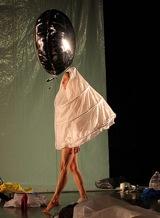San Francisco Ring: Confirmed and Surprising
The very existence of San Francisco Opera's 2011 Der Ring des Nibelungen, confirmed in a company announcement today, is a hard-won, delightful surprise. Only four years ago, General Director David Gockley and Donald Runnicles (then music director) drew up plans, but in a different world.
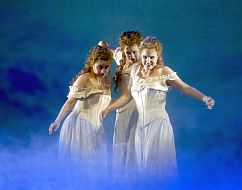
With the economy hitting bottom since, coproducer Washington National Opera dropped the project three-quarters of the way through the cycle (planning a concert performance of Götterdämmerung), Los Angeles Opera's Ring was modified in a major way, and San Francisco itself postponed the project by a year. (Seattle and several European companies came through pretty much intact.)
And now it's all happening, a multimillion-dollar enterprise, very close to the original Gockley-Runnicles plans. The schedule for three cycles calls for performances from June to July in 2011, and Runnicles is returning to the city to conduct it. His 1990 performances earned him the music director's position here two years later. He has been on the podium for the Wagner ever since, including the last production a decade ago.
As originally announced, the Francesca Zambello production will feature Nina Stemme as Brünnhilde and Mark Delavan as Wotan. Principal singers include Anja Kampe (Sieglinde), Larissa Diadkova (Fricka), David Cangelosi (Mime), and there are company debuts for Ian Storey (Siegfried) and Gordon Hawkins (Alberich).
A surprise assignment is Brandon Jovanovich as Siegmund. Known here for his Puccini heroes (a notable Pinkerton in Madama Butterfly before, and, currently, Luigi in Il tabarro), Jovanovich has been steadily stretching the voice and expanding his repertoire, singing Peter Grimes this season, and getting ready for an Ariadne auf Naxos Bacchus next year in Boston. But Siegmund will be apparently his first Wagner, and it's a big move, although there have been lyric tenors before who "broke into Wagner" with Siegmund; Merola alumnus Stuart Skelton is a recent example.
Stefan Margita returns as Loge, Gerd Grochowski appears as Gunther, and Andrea Silvestrelli will sing Fasolt and Hagen. Adler Fellow Heidi Melton will sing Sieglinde on the June 29 performance of Die Walküre as the Third Norn in all performances of Götterdämmerung.

Merola alumna Ronnita Miller makes her company debut as Erda as well as the First Norn, and Daniel Sumegi sings Fafner and Hunding. Another Merola alumna, Melissa Citro, appears as Gutrune and Freia, and Adler Fellow Daveda Karanas sings Waltraute and Second Norn.
The 2011 cycles are set for June 14–19, June 21–26, and June 28–July 3. Die Walküre will be introduced as part of the 2010 summer season. The first three operas are coproductions with Washington National Opera; Götterdämmerung is a new production here.
On the occasion of the Ring Festival, the Opera will host numerous related activities throughout the Bay Area, including lectures, musical performances, film screenings, exhibits, and other events. The theme of "American Ring" remains, with the creative team of Catherine Zuber as costume designer, Mark McCullough as lighting designer, Jan Hartley as projection designer, and Cori Ellison as dramaturg.
Says Zambello:
My challenge was to set Wagner’s themes into a visual world that parallels our own. The production has both a realistic edge and a fantastical dimension. My hope is the audience will intuit the connections to the world today while fully entering into the realm of myth.From Runnicles:
It is best to come to the Ring with a sense of and desire for adventure. In the unfolding of this remarkable odyssey, the mythological story of the Ring illuminates so many things — true love, greed, power, possession, parenthood, and moral maturity. In common with all great works of drama, Wagner’s epic can touch each of our lives profoundly and unforgettably.
Support the Arts? No, Tax 'Em!
"Arts community shocked by new tax burden," says the headline in The Philadelphia Inquirer, in which Stephan Salisbury reports on a budget measure extending the state sales tax to cultural performances and venues — including museums — but not to sports events.The plan calls for the creation of a special fund for cultural institutions and the arts, the money to be used to support institutions previously subsidized by the general fund. Senate Republicans, who had steadfastly opposed any new taxes, insisted on the fund.Even though state officials said some portion of the new cultural sales tax would flow back to venues — and the exact nature of this remained murky — arts administrators pointed out that state support had already been radically reduced. In fact, in the case of historical museums and sites, it has been eliminated.
Now cultural officials contend that audiences and visitors will be hit in the pocketbook, possibly reducing their desire to attend events and further reducing revenue.
The $27.9 billion state spending plan announced Friday night includes expansion of the state sales tax to performing-arts programs — dance, music, theater — and other cultural venues, such as museums and zoos, to generate about $100 million. The tax would not be imposed on movies or sports events.
Happy Musical 5770!
To bring together Jewish New Year and music, take a look at Opera Nostalgia.
Click on Nostalgic Sound Bites and explore Israeli art song repertoire, an aria from the first-ever Israeli opera, a cantor having a go at Donizetti's Poliuto, Judas Maccabeus in Hebrew, and an excerpt from the first Aida performance in Israel. L'shana tovah!
Cao to Sing for All the Presidents
Mezzo Zheng Cao, whose recovery from multiple cancers is regularly chronicled here, is about to sing for Presidents Obama, Bush I and II, Clinton, and — possibly — Carter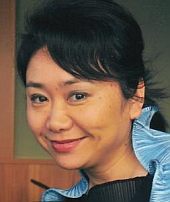
I've been singing a lot lately, including for the memorial of a lovely nurse at Mt. Zion. But the biggest thrill coming up is that I will be singing at the opening ceremony of President's Cup Golf Tournament at [San Francisco's] Harding Park in front of all the living presidents!I will be singing the National Anthem with the Air Force Band followed by a fly-by of U.S. Navy F-18 fighter jets directly after I finish my last note. I'm praying that I don't sing 'Jose, can you see?' And god help me with all my final consonants! The ceremony will be telecast on NBC and ESPN on October 7th at 4:15 Pacific Time. Check your local listings.
Jasraj Returns
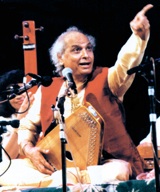
The great Hindustani singer, whose last appearance in San Francisco seven years ago reminded me of both Carlo Bergonzi and instrumental circular breathing (see below), is returning to the Bay Area, alas, only after the death of his good friend, Ali Akbar Khan.
Pandit Jasraj will give a concert Oct. 3, at the Chabot Performing Arts Center in Hayward. Says the announcement: "Possessing a soulful voice that traverses effortlessly over three and a half octaves, Pandit Jasraj’s vocals culminate in an intense spiritual expression. At the same time, concertgoers will experience the rich cultural tradition of India's Mewati Gherana, the classical music style perfected by Jasraj."
Accompanying Jasraj are classical vocalists Tripti Mukherjee and Suman Ghosh, and tabla player Swapan Chaudhuri. The four artists will perform together for the first time in the Bay Area. The concert is a benefit for Berkeley's Archway School.
Here is an excerpt from a report on Jasraj's last appearance here:
With his flowing white hair, Jasraj appeared to be of an age when Western singers would be long retired. In fact, when he began his set, there was not much of his once mighty voice in evidence. But then — contrary to physics and logic — he gathered strength as time went on. And, regardless of how much voice he produced, the phrasing, the intensity, the music came across beautifully.Never mind the difference in geography and genre between Indian raga and Italian opera, Jasraj's performance reminded me powerfully of Carlo Bergonzi's last appearance in San Francisco, at the end of his career. It was Un Ballo in Maschera without much voice, but with Bergonzi's elegant phrasing and unsentimental lyricism more affecting than ever.
Jasraj has something else remaining: a breathing technique that no opera singer I ever heard could imitate. He and Sachdev both exhibit stunning circular breathing, enabling the flutist to produce an unbroken 20-minute phrase (we are in the world of the raga, folks) and the singer to bridge three octaves, dip very low, do a splendid messa di voce and keep exhaling sound without visibly or audibly inhaling at all. We are not talking about Yma Sumaclike circus, but rather a technique, a way of singing that serves the music.
Graham: 99-44/100% Pure and Floating
Although guilty of it myself in the past, I object to calling any performance "perfect." How can anything be "complete of its kind and without defect or blemish"?

Last week, I was sorely tempted to report perfection at the San Francisco Symphony performance of Mahler's Rückert Songs, conducted by Michael Tilson Thomas and sung by Susan Graham. (See Georgia Rowe's review of the whole concert in this issue.)
Lack of bitterness or even resignation in the interpretation gave me the excuse to opt for the Ivory Soap slogan, but otherwise, yes, there was the "P" word all around Davies Symphony Hall.
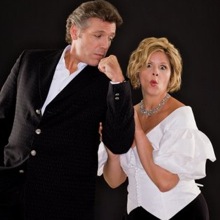
Next week, various Mahler programs will be anchored by Songs of the Wayfarer with Thomas Hampson as the soloist. It's a matter of local pride that Graham, Hampson, and Patricia Racette (singing in Trittico across Grove Street, in the War Memorial), and Patrick Summers (conducting Trittico) all came through the San Francisco Opera Merola Program, all within a few years: 1987, 1980, 1988, and 1986, respectively.
Beyond those four in the city this week, the Merola Program in that decade also yielded — among hundreds — Kevin J. Langan (bass, 1980), Patricia Schuman (soprano, 1980), Ruth Ann Swenson (soprano, 1981-'82), Sylvia McNair (soprano, 1982), Richard Paul Fink (baritone, 1983), Dolora Zajick (mezzo, 1983), Tracy Dahl (soprano, 1985), Mark Delavan (bass, 1985 [our Wotan-to-be]), Philip Skinner (bass, 1985), Deborah Voigt (soprano, 1985), Laura Claycomb (soprano, 1989), and Mary Mills (soprano, 1989).
What was in the water in the '80s?
Intonarumori: the Past and Future (?) of Futurism
Part of SF MoMA's upcoming celebration of Metal + Machine + Manifesto = Futurism's First 100 Years is a concert called "Music for 16 Futurist Noise Intoners," on Oct. 16, in the Novellus Theater of the Yerba Buena Center for the Arts.
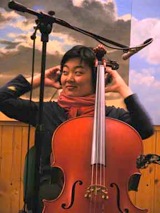
On the program: new compositions by Mike Patton, Text of Light, Blixa Bargeld, Carla Kihlstedt and Mattias Bossi, Elliott Sharp, Ulrich Krieger, Ellen Fullman, James Fei, Luciano Chessa, John Butcher and Gino Robair, Pablo Ortiz, Theresa Wong, and the sfSoundGroup.
Performers include players from Magik*Magik Orchestra.
Futurist sound artist Luigi Russolo constructed special hand-cranked instruments to realize an expanded field of orchestral sound. Called intonarumori (noise intoners), these instruments could produce noises — explosions, howls, buzzes, hisses — not usually employed in Western music.
Luciano Chessa, a Bay Area-based composer and Russolo scholar, has overseen the re-creation of 16 intonarumori and has curated this concert of original and newly commissioned scores.
Music Films at Mill Valley Festival
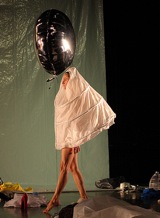
The 32nd annual Mill Valley Film Festival, Oct. 8-18, includes several new documentaries about music and dance:
- A Sweeter Music: A Live Concert by Sarah Cahill (Oct. 18) is John Sanborn's video portrait of pianist, writer, and radio host Sarah Cahill — her life and music.
- Meredith Monk: Inner Voice (Oct. 15, 18) is a Dutch-U.S. film about the singer-composer, directed by Babeth M. VanLoo. It offers insight into Monk's pioneering works and an exploration of the connections between creativity and spirituality.
- Breath Made Visible (Oct. 10, 12) is a fascinating documentary about dancer/choreographer Anna Halprin. At 89, the Marin-based, avant-garde dance pioneer still hard at work, performs, teaches movement to seniors, dances with Merce Cunningham, battles cancer, and combats racism.
VoiceBox Coming to KALW-FM
San Francisco journalist Chloe Veltman, a singer herself, is hosting and producing a radio program about singing, called VoiceBox. The series is scheduled to open Friday nights on KALW 91.7 FM in January.Sponsored in part by Independent Arts & Media (but still in need of more funding for production costs), VoiceBox aims "to highlight the work of the most captivating singers past and present, while encouraging listeners to both broaden their musical horizons and participate in local singing activities."
Veltman has produced a five-part pilot series, available here.
Creative Work Awards
San Francisco's Creative Work Fund has announced 17 grants, totaling $670,000, to Bay Area artists and nonprofit organizations for collaborations leading to new art works.
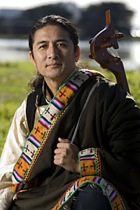
The awards range from $30,000 to $40,000.
Creative Work Fund Executive Director Frances Phillips says the awards recognize
... artists working at the cutting edge of new technology while also immersing themselves deeply in the past to, for example, excavate the Punjabi-Mexican community of the Central Valley or to research and create a traditional Ohlone presentation basket — something no Rumsien Ohlone artist has done in 300 years.Since 1994, the Fund says, it has contributed $7.4 million to assist Bay Area artists in a variety of disciplines. The organization is currently inviting letters of inquiry for 2010 grants, and is hosting a series of informational seminars in 14 Bay Area counties.
Among the new awardees:
- Hugh Livingston, who lives in Oakland and is collaborating with Russian Riverkeeper to create a sound sculpture for a new park at a bend in the river. He is an accomplished cellist who has moved into creating sound environments.
- Sali Rumen Shopov, a traditional Roma (gypsy) musician, is highly accomplished yet supports himself by driving a cab in Berkeley. He collaborates with Voice of Roma on traditional Balkan brass band music.
- Tibetan traditional artist Techung (Tashi Sharzur); he and his band Lhasa Spirits are going on a North American tour this fall, partnering up with Students for Free Tibet and Tibetan communities.
OperaVision Glitch to Be Corrected
Leading up to the Trovatore simulcast in the ballpark on Saturday, there have been complaints about OperaVision in the upper reaches of the War Memorial, such as... it is now SquintVision: the screens drop down only about half way, compared with previous seasons, although they do attempt to show everything. At first, I thought this was a technical problem, but then I realized that it was the way it is intended to be ... in some attempt at compromise with season ticket holders who find them annoying, last night the screens only came halfway down and all the shots were framed at a ridiculous widescreen aspect ratio, which made me feel sorry for the fine videographers. In any case, the experiment didn't work very well as it felt a bit like watching a Cinerama film on an iPhone.Response from General Director David Gockley:
I'm aware of this problem. The squat image is because we're rehearsing shots for the shape of the ballpark screen. We should have stuffed an explanation in the balcony programs. We'll make sure that it does not happen again, though actually it will happen once more Saturday, the actual simulcast. Usually we have OperaVision at the end of the run, when we are better prepared with the shots. No excuses. There was also an element of "bad night" in the mix.
HD Operas From the Met
Nine operas will be transmitted in high definition to some 500 theaters and performing art centers in North America from the Metropolitan Opera during the current season that opened Monday night. The first four are:
- Oct. 10, Puccini's Tosca, with Karita Mattila (repeated Oct. 28)
- Oct. 24, Verdi's Aida, with Violeta Urmana in the title role, Daniele Gatti conducting (repeated Nov.11)
- Nov. 7 Puccini's Turandot, in the Franco Zeffirelli production, Maria Guleghina in the title role, Marcello Giordani as Calaf (repeated Nov. 18)
- Dec. 19, Offenbach's The Tales of Hoffmann, with Anna Netrebko, Ekaterina Gubanova, and Kathleen Kim as the heroines

